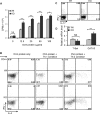B7-H3 Promotes Pathogenesis of Autoimmune Disease and Inflammation by Regulating the Activity of Different T Cell Subsets
- PMID: 26065426
- PMCID: PMC4465912
- DOI: 10.1371/journal.pone.0130126
B7-H3 Promotes Pathogenesis of Autoimmune Disease and Inflammation by Regulating the Activity of Different T Cell Subsets
Abstract
B7-H3 is a cell surface molecule in the immunoglobulin superfamily that is frequently upregulated in response to autoantigens and pathogens during host T cell immune responses. However, B7-H3's role in the differential regulation of T cell subsets remains largely unknown. Therefore, we constructed a new B7-H3 deficient mouse strain (B7-H3 KO) and evaluated the functions of B7-H3 in the regulation of Th1, Th2, and Th17 subsets in experimental autoimmune encephalomyelitis (EAE), experimental asthma, and collagen-induced arthritis (CIA); these mouse models were used to predict human immune responses in multiple sclerosis, asthma, and rheumatoid arthritis, respectively. Here, we demonstrate that B7-H3 KO mice have significantly less inflammation, decreased pathogenesis, and limited disease progression in both EAE and CIA mouse models when compared with littermates; these results were accompanied by a decrease in IFN-γ and IL-17 production. In sharp contrast, B7-H3 KO mice developed severe ovalbumin (OVA)-induced asthma with characteristic infiltrations of eosinophils in the lung, increased IL-5 and IL-13 in lavage fluid, and elevated IgE anti-OVA antibodies in the blood. Our results suggest B7-H3 has a costimulatory function on Th1/Th17 but a coinhibitory function on Th2 responses. Our studies reveal that B7-H3 could affect different T cell subsets which have important implications for regulating pathogenesis and disease progression in human autoimmune disease.
Conflict of interest statement
Figures






References
-
- Chapoval AI, Ni J, Lau JS, Wilcox RA, Flies DB, Liu D, et al. B7-H3: a costimulatory molecule for T cell activation and IFN-gamma production. Nat Immunol. 2001. March;2(3):269–274. - PubMed
-
- Hashiguchi M, Kobori H, Ritprajak P, Kamimura Y, Kozono H, Azuma M. Triggering receptor expressed on myeloid cell-like transcript 2 (TLT-2) is a counter-receptor for B7-H3 and enhances T cell responses. Proc Natl Acad Sci U S A. 2008. July 29;105(30):10495–10500. 10.1073/pnas.0802423105 - DOI - PMC - PubMed
Publication types
MeSH terms
Substances
Grants and funding
LinkOut - more resources
Full Text Sources
Other Literature Sources
Medical
Molecular Biology Databases
Research Materials

